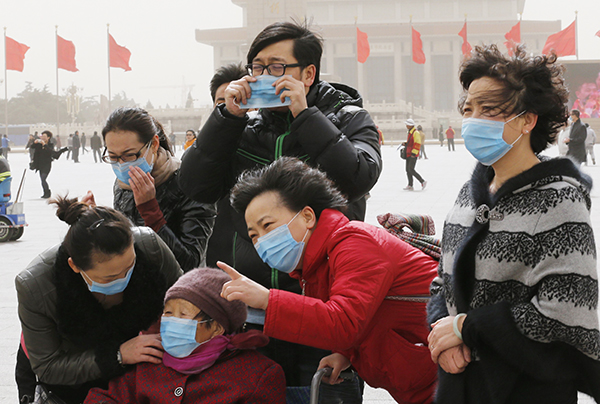China’s problem choking Koreans

Lawmaker Park In-sook, a pediatrician, visited Beijing last week amid the thick smog, and she advised me to get X-ray checkups every six months and to send my children back to Korea. However, as a journalist, my job calls for me to run to the places with the heaviest smog to cover the story.
In fact, 1.4 billion Chinese are destined to live with unbearable levels of air pollution. To foreigners who just arrived in Beijing, the Chinese seem almost insensitive. Automobile exhaust emissions are one of the three major causes of the smog, and the authorities encourage mass transit. But the beltway around Beijing is jammed all day long.
Government leaders have been advocating environmental preservation for more than a decade, but recycling and separate trash collection are not mandatory in Beijing.
The problem is that China’s smog does not remain in China. When smog occurs in Beijing, it almost always travels to the Korean Peninsula the next day. The Yellow Sea (called the West Sea in Korea) between China and the peninsula is too narrow to filter away the pollutants. That’s why we can no longer overlook China’s air pollution.
Given the serious level of smog from all sources of contamination, international cooperation is desperately needed. Many Chinese people still feel grateful that the Korean government and civilian groups helped plant trees in China’s western regions to prevent desertification. It is about time that we work together to research and develop environmental technologies to reduce smog. Japan is in the same situation.
Last week, 41 lawmakers came to Beijing to meet with Chinese leaders. They discussed North Korean nuclear issues and the free trade agreement, and criticized Japan’s distorted historical perspective. However, there was no mention of cooperation on smog reduction. They may not have time to address the issue now, but it does need to be addressed. After I came to Beijing, I realized that people need to breathe to live.
JoongAng Ilbo, Feb. 25, Page 30
*The author is the Beijing correspondent for the JoongAng Ilbo.
By YEH YOUNG-JUNE
베이징 특파원으로 갓 부임한 기자의 휴대폰에는 '베이징 공기'란 이름의 어플리케이션이 깔려 있다. 한국에 있을 땐 이런 앱도 있는지 생각도 못했던 일인데 여기선 하루에도 몇번씩 들여다보게 된다. 내가 있는 곳의 초미세먼지 농도를 실시간으로 알려 주는 앱이다. 지금 켜보니 411이란 숫자가 나온다. 농도가 350 이상일 땐 실외 신체 활동을 중지하라는 설명도 붙어 있다. 지난주 베이징에 왔다가 스모그 세례를 받은 소아과 전문의 출신의 박인숙 의원은 “6개월에 한차례씩 엑스레이 촬영을 하고 아이는 속히 한국으로 돌려 보낼 것”을 권유했다. 하지만 어쩌랴, 스모그가 발생하면 즉시 현장으로, 그것도 가장 심한 곳으로 달려가야 하는 특파원의 숙명을. 숙명으로 치자면 14억 중국인들이야말로 스모그와 함께 평생을 살아가야 할 사람들이다. 그래서일까, 갓 베이징에 온 이방인의 눈에 중국인들은 대범하다 못해 둔감해 보인다. 자동차 배기가스가 스모그 3대 주범의 하나라며 대중교통 사용을 독려해도 여전히 베이징의 순환도로는 하루 종일 정체에 시달린다. 정부지도자들은 십수년째 ‘환바오’ (環保ㆍ환경보호)를 입에 달고 있지만 베이징에선 쓰레기 분리수거조차 의무화되어 있지 않다. 문제는 이게 남의 일만은 아니란 데 있다. 베이징에 스모그가 발생하면 어김없이 이튿날 한반도에 영향을 미친다. 선인들이 중국과 한반도 사이의 서해를 일의대수(一衣帶水)라고 한 걸 이로써 실감한다. 베이징의 스모그가 바다를 건너며 오염물질을 날려보내기엔 서해의 폭이 너무나 좁다. '바다 건너 스모그 구경하듯' 할 수 없는 이유다. 그래서 꼭 필요한 게 국제협력이다. 예전에 한국 정부·민간이 황사 발원지인 중국 서부 내륙에 조림사업을 펼쳐 사막화 방지에 힘을 보탠 것을 감사하게 여기는 중국인들이 지금도 적지 않다. 이젠 스모그 완화를 위한 공동연구와 환경 기술 협력에 힘과 지혜를 모아야 한다. 이런 사정은 일본도 마찬가지다. 지난주 41명의 국회의원단이 베이징에 와서 중국 지도자들과 만났다. 북핵·자유무역협정(FTA) 등에 대해 고담준론을 나누고 일본의 그릇된 과거사 인식에 대한 비판에 함께 목청을 높이며 의기투합했다고 한다. 하지만 스모그 문제에 대한 협력방안을 진지하게 논의했다는 말은 없었다. 혹 시간 제약 때문에 그랬다면 지금이라도 스모그 문제를 양국 협력의 의제로 제시했으면 한다. 사람은 숨을 쉬며 사는 존재라는 걸 베이징에 와서 비로소 깨달았기에 드리는 말씀이다. 예영준 베이징 특파원










with the Korea JoongAng Daily
To write comments, please log in to one of the accounts.
Standards Board Policy (0/250자)